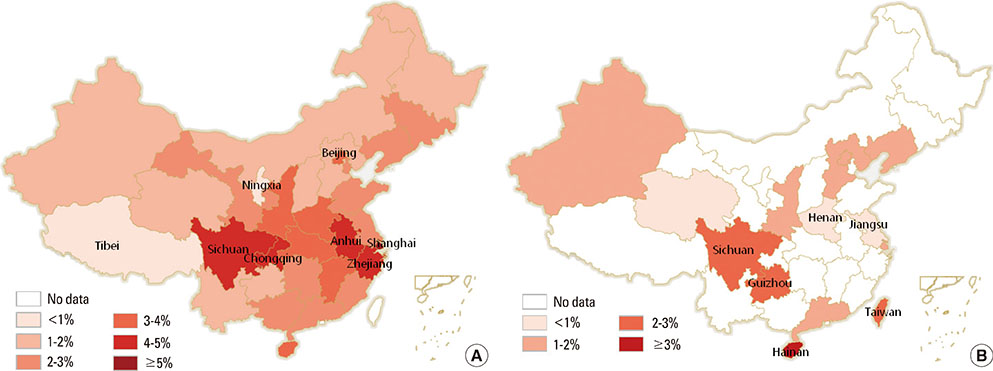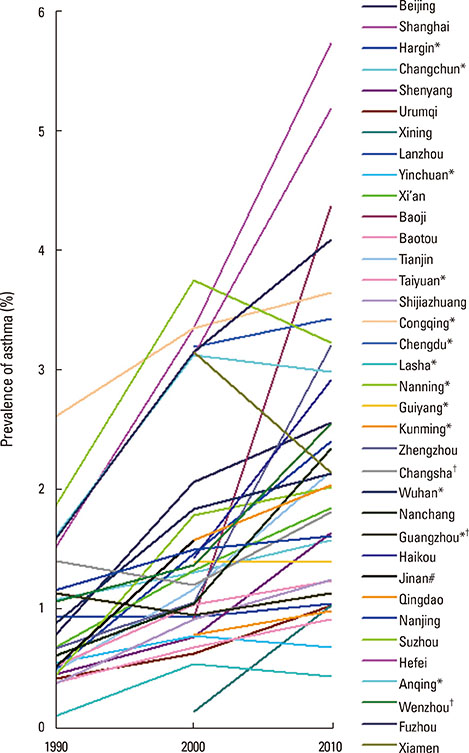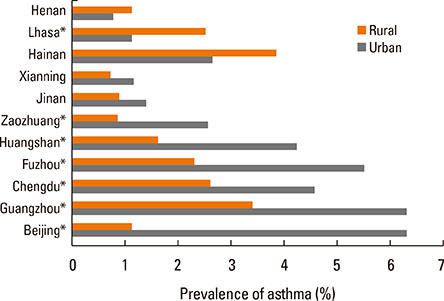Environmental Exposure and Genetic Predisposition as Risk Factors for Asthma in China
- Affiliations
-
- 1State Key Laboratory of Respiratory Disease, The First Affiliated Hospital, Guangzhou Medical University, Guangzhou, China. lijing@gird.cn
- 2Guangdong Pharmaceutical University, Guangzhou, China.
- 3Department of Pediatrics, Prince of Wales Hospital, The Chinese University of Hong Kong, China.
- KMID: 2165924
- DOI: http://doi.org/10.4168/aair.2016.8.2.92
Abstract
- Asthma is the most common chronic pulmonary disease worldwide and places a considerable economic burden on society. China is the world's largest developing country and has the largest population. China has undergone dramatic changes in the past few decades. The traditional lifestyle and living environment have changed in ways that directly affect the prevalence of asthma. The prevalence of asthma is lower in Chinese children and adults than in developed countries, but the prevalence has been on the rise during the past 30 years. The prevalence significantly varies among different parts of China. Polymorphisms of multiple genes, outdoor air pollution caused by PM2.5, PM10, SO2, NO2, environmental tobacco smoke, and coal, indoor pollution, and inhaled allergens, such as house dust mites, pollen, and cockroach particles, are risk factors for asthma.
Keyword
MeSH Terms
-
Adult
Air Pollution
Allergens
Asian Continental Ancestry Group
Asthma*
Child
China*
Coal
Cockroaches
Developed Countries
Developing Countries
Environmental Exposure*
Genetic Predisposition to Disease*
Humans
Life Style
Lung Diseases
Pollen
Polymorphism, Genetic
Prevalence
Pyroglyphidae
Risk Factors*
Smoke
Tobacco
Allergens
Coal
Smoke
Figure
Cited by 3 articles
-
Short-term Haze Exposure Predisposes Healthy Volunteers to Nasal Inflammation
Mu Xian, Kuiji Wang, Hongfei Lou, Yang Wang, Luo Zhang, Chengshuo Wang
Allergy Asthma Immunol Res. 2019;11(5):632-643. doi: 10.4168/aair.2019.11.5.632.Investigation of the Possible Role of the Hippo/YAP1 Pathway in Asthma and Allergy
Lili E. Fodor, András Gézsi, ldikó Ungvári, Ágnes F. Semsei, Zsófia Gál, Adrienne Nagy, Gabriella Gálffy, Lilla Tamási, András Kiss, Péter Antal, Csaba Szalai
Allergy Asthma Immunol Res. 2017;9(3):247-256. doi: 10.4168/aair.2017.9.3.247.Allergic Rhinitis in Preschool Children and the Clinical Utility of FeNO
Jisun Yoon, Yean Jung Choi, Eun Lee, Hyun-Ju Cho, Song-I Yang, Young-Ho Kim, Young-Ho Jung, Ju-Hee Seo, Ji-won Kwon, Hyo-Bin Kim, So-Yeon Lee, Bong-Seong Kim, Jung Yeon Shim, Eun-Jin Kim, Joo-Shil Lee, Soo-Jong Hong
Allergy Asthma Immunol Res. 2017;9(4):314-321. doi: 10.4168/aair.2017.9.4.314.
Reference
-
1. Masoli M, Fabian D, Holt S, Beasley R. Global Initiative for Asthma (GINA) Program. The global burden of asthma: executive summary of the GINA Dissemination Committee report. Allergy. 2004; 59:469–478.2. Asthma Group of Chinese Society of Respiratory Diseases. Guidelines for prevention and treatment of asthma. Chin J Tuberc Respir Dis. 2008; 31:177–185.3. Asher MI, Montefort S, Björkstén B, Lai CK, Strachan DP, Weiland SK, et al. Worldwide time trends in the prevalence of symptoms of asthma, allergic rhinoconjunctivitis, and eczema in childhood: ISAAC Phases One and Three repeat multicountry cross-sectional surveys. Lancet. 2006; 368:733–743.4. Lee SL, Wong W, Lau YL. Increasing prevalence of allergic rhinitis but not asthma among children in Hong Kong from 1995 to 2001 (Phase 3 International Study of Asthma and Allergies in Childhood). Pediatr Allergy Immunol. 2004; 15:72–78.5. Wong GW, Leung TF, Ko FW, Lee KK, Lam P, Hui DS, et al. Declining asthma prevalence in Hong Kong Chinese schoolchildren. Clin Exp Allergy. 2004; 34:1550–1555.6. Droma Y, Kunii O, Yangzom Y, Shan M, Pingzo L, Song P. Prevalence and severity of asthma and allergies in schoolchildren in Lhasa, Tibet. Clin Exp Allergy. 2007; 37:1326–1333.7. Ma Y, Zhao J, Han ZR, Chen Y, Leung TF, Wong GW. Very low prevalence of asthma and allergies in schoolchildren from rural Beijing, China. Pediatr Pulmonol. 2009; 44:793–799.8. Zhao J, Bai J, Shen KL, Xiang L, Huang Y, Huang S, et al. Questionnaire-based survey of allergic diseases among children aged 0-14 years in the downtown of Beijing, Chongqing and Guangzhou. Zhonghua Er Ke Za Zhi. 2011; 49:740–744.9. Wang HY, Zheng JP, Zhong NS. Time trends in the prevalence of asthma and allergic diseases over 7 years among adolescents in Guangzhou city. Zhonghua Yi Xue Za Zhi. 2006; 86:1014–1020.10. Li J, Wang H, Chen Y, Zheng J, Wong GW, Zhong N. House dust mite sensitization is the main risk factor for the increase in prevalence of wheeze in 13- to 14-year-old schoolchildren in Guangzhou city, China. Clin Exp Allergy. 2013; 43:1171–1179.11. Song N, Shamssain M, Zhang J, Wu J, Fu C, Hao S, et al. Prevalence, severity and risk factors of asthma, rhinitis and eczema in a large group of Chinese schoolchildren. J Asthma. 2014; 51:232–242.12. Dong GH, Chen T, Liu MM, Wang D, Ma YN, Ren WH, et al. Gender differences and effect of air pollution on asthma in children with and without allergic predisposition: northeast Chinese children health study. PLoS One. 2011; 6:e22470.13. Wilson D, Takahashi K, Pan G, Chan CC, Zhang S, Feng Y, et al. Respiratory symptoms among residents of a heavy-industry province in China: prevalence and risk factors. Respir Med. 2008; 102:1536–1544.14. Shi Z, Yuan B, Wittert GA, Pan X, Dai Y, Adams R, et al. Monosodium glutamate intake, dietary patterns and asthma in Chinese adults. PLoS One. 2012; 7:e51567.15. Li F, Zhou Y, Li S, Jiang F, Jin X, Yan C, et al. Prevalence and risk factors of childhood allergic diseases in eight metropolitan cities in China: a multicenter study. BMC Public Health. 2011; 11:437.16. Chen YZ. National Cooperation Group On Childhood Asthma China. Comparative analysis of the state of asthma prevalence in children from two nation-wide surveys in 1990 and 2000 year. Zhonghua Jie He He Hu Xi Za Zhi. 2004; 27:112–116.17. Chen YZ. National Cooperation Group On Childhood Asthma. A nationwide survey in China on prevalence of asthma in urban children. Zhonghua Er Ke Za Zhi. 2003; 41:123–127.18. National Cooperative Group on Childhood Asthma. Institute of Environmental Health and Related Product Safety, Chinese Center for Disease Control and Prevention. Chinese Center for Disease Control and Prevention. Third nationwide survey of childhood asthma in urban areas of China. Zhonghua Er Ke Za Zhi. 2013; 51:729–735.19. Feng XK. An epidemiology survey on the prevalence and associated risk factors of asthma among adults in China [dissertation]. Beijing: Peking Union Medical College;2015.20. Wang G, Peng Y, Du C, Tang B, Liu J, Zhen X, et al. Epidemiological survey on bronchial asthma in Henan province. Zhonghua Jie He He Hu Xi Za Zhi. 2002; 25:25–28.21. Zhang SZ, Xi Q, Kong WS, Li ZH, Kong XT, Kong LY, et al. Study on prevalence and correlation factors of bronchial asthma in Zaozhuang area, Shandong province. Zhonghua Liu Xing Bing Xue Za Zhi. 2005; 26:273–276.22. Ding YP, Yao HX, Tang XL, He HW, Shi HF, Lin L, et al. An epidemiology study of bronchial asthma in the Li ethnic group in China. Asian Pac J Trop Med. 2012; 5:157–161.23. Gao F, Yang QJ, Zhang HG. An epidemiological study of bronchial asthma in Qinghai province. Zhonghua Jie He He Hu Xi Za Zhi. 2011; 34:165–168.24. Wang D, Xiao W, Ma D, Zhang Y, Wang Q, Wang C, et al. Cross-sectional epidemiological survey of asthma in Jinan, China. Respirology. 2013; 18:313–322.25. Yang Y, Li P, Song FY, Xiong QJ, Li ZF, Wei YP, et al. Analysis of the prevalence and risk factors of miao nationality population in the rural areas of qiannan autonmous preffcture of Guizhou province. Xian Dai Yu fang Yi Xue. 2012; 39:2142–2144. 214726. Qian JJ, Ma JY, Zhou M, Zhou X. A survey on epidemiology and risk factors of bronchial asthma in Baoshan district of Shanghai. J Intern Med Concepts Pract. 2011; 6:121–124.27. Chai WS, Zhang DD, Pan DZ, Che LY. Epidemiological survey of asthma condition and risk factors in Jinzhou city. Chin Gen Pract. 2013; 16:413–414. 42428. Hwang CY, Chen YJ, Lin MW, Chen TJ, Chu SY, Chen CC, et al. Prevalence of atopic dermatitis, allergic rhinitis and asthma in Taiwan: a national study 2000 to 2007. Acta Derm Venereol. 2010; 90:589–594.29. Lei M, Zeng HY, Yu Y. Epidemiological investigation of bronchial asthma in Xianning city. China Trop Med. 2005; 5:258–260.30. Cui ZZ, Wang WL, Huang Y, Mu HM, Jing SJ, Zhao XH. Epidemiological investigation on children under 14 years old with asthma in DaLian city. Bull Med Res (Chin). 2002; 31:57–59.31. Yuan BH, Cheng LY, Tao Y, Li L. Epidemiological investigation on asthma in 0-14 years old children in Xiangtan city. Zhongguo Fu You Bao Jian. 2012; 27:98–99.32. Wang SY, Ding H, Wang SQ. Survey on prevalence rate of children with asthma in Zaozhuang city. Mod Prev Med. 2007; 34:83–84.33. Shi CH, Zhang W, Jing YH, Wang LX, Zhang G, Cheng YL, et al. Epidemiological study on bronchial asthma among 0-14 years old children in Jilin. Chin J Child Health Care. 2013; 21:645–648.34. Song J, Li Q, Sun YH, Gong MY. Analysis of the risk factors for asthma in children in WeiHai city. Matern Chilld Health Care Chin. 2013; 28:4667–4668.35. Kong Y, Ren CY, Cheng YJ, Yang A, Wang LZ, Xia JH. Epidemiological study on the sickness rate of asthma in children of 0-14 years old in urban area of Huainan city. Chin J Child Health Care. 2006; 295–296.36. Zhou BJ, Pan JH, Yu XK, Cheng AP, Zhou XL, Bi SF. Epidemiological investigation on 0-14 childhood asthma in Huangshan district. Chin J Dis Control Prev. 2012; 16:268–270.37. Sun LB, Wang YT, Wan WJ, Ren HL, Gu AL. Epidemiological investigation on children under 14 years old with asthma in Chaohu city. Chin J Dis Control Prev. 2008; 12:498–500.38. Kong T. Analysis of epidemiological investigation and prevention of childhood asthma. Clin J Chin Med. 2014; 6:27–28.39. Liu SM, Wang XX, Liang QQ, Wang W, Dong CF. Epidemiological study on asthma among children aged 0 to 14 years in Shaoxing. J Pract Med (Chin). 2006; 22:2546–2547.40. Schernhammer ES, Vutuc C, Waldhör T, Haidinger G. Time trends of the prevalence of asthma and allergic disease in Austrian children. Pediatr Allergy Immunol. 2008; 19:125–131.41. Mvula M, Larzelere M, Kraus M, Moisiewicz K, Morgan C, Pierce S, et al. Prevalence of asthma and asthma-like symptoms in innercity schoolchildren. J Asthma. 2005; 42:9–16.42. Kurukulaaratchy RJ, Fenn M, Twiselton R, Matthews S, Arshad SH. The prevalence of asthma and wheezing illnesses amongst 10-year-old schoolchildren. Respir Med. 2002; 96:163–169.43. Wang XS, Tan TN, Shek LP, Chng SY, Hia CP, Ong NB, et al. The prevalence of asthma and allergies in Singapore; data from two ISAAC surveys seven years apart. Arch Dis Child. 2004; 89:423–426.44. Akinbami LJ, Moorman JE, Bailey C, Zahran HS, King M, Johnson CA, et al. Trends in asthma prevalence, health care use, and mortality in the United States, 2001-2010. NCHS Data Brief. 2012; 1–8.45. Gershon AS, Guan J, Wang C, To T. Trends in asthma prevalence and incidence in Ontario, Canada, 1996-2005: a population study. Am J Epidemiol. 2010; 172:728–736.46. Tang T, Ding Y, Zhen J. Epidemiological survey and analysis on bronchial asthma in Guangdong province. Zhonghua Jie He He Hu Xi Za Zhi. 2000; 23:730–733.47. Chen P, Yu R, Hou X, Tan P, Xie H, Kong L, et al. Epidemiological survey on bronchial asthma in Liaoning province. Zhonghua Jie He He Hu Xi Za Zhi. 2002; 25:603–606.48. Wang Q, Xu C, Xu D, Liu C, Chen Y. Risks on asthma among city children in China:a nationwide case-control study. Zhonghua Liu Xing Bing Xue Za Zhi. 2014; 35:237–241.49. Leung TF, Wong GW. The Asian side of asthma and allergy. Curr Opin Allergy Clin Immunol. 2008; 8:384–390.50. Lee JH, Park CS. Gene-Gene interactions among MCP genes polymorphisms in asthma. Allergy Asthma Immunol Res. 2014; 6:333–340.51. Zhao CN, Fan Y, Huang JJ, Zhang HX, Gao T, Wang C, et al. The association of GSDMB and ORMDL3 gene polymorphisms with asthma: a meta-analysis. Allergy Asthma Immunol Res. 2015; 7:175–185.52. Liu W, Xu LS, Liu QJ, Dong FZ, Qiu RF, Wen MC, et al. Two single nucleotide polymorphisms in TSLP gene are associated with asthma susceptibility in Chinese Han population. Exp Lung Res. 2012; 38:375–382.53. Chen J, Deng Y, Zhao J, Luo Z, Peng W, Yang J, et al. The polymorphism of IL-17 G-152A was associated with childhood asthma and bacterial colonization of the hypopharynx in bronchiolitis. J Clin Immunol. 2010; 30:539–545.54. Wang J, Simayi M, Wushouer Q, Xia Y, He Y, Yan F, et al. Association between polymorphisms in ADAM33, CD14, and TLR4 with asthma in the Uygur population in China. Genet Mol Res. 2014; 13:4680–4690.55. Yuan P, Wei L, Hao S, Qiao L, Liu Y, Liu P, et al. Association between indoor coal-burning pollutants associated with asthmatic susceptible genetic polymorphisms in childhood asthma. Wei Sheng Yan Jiu. 2008; 37:159–163.56. Fang Q, Zhao H, Wang A, Gong Y, Liu Q. Association of genetic variants in chromosome 17q21 and adult-onset asthma in a Chinese Han population. BMC Med Genet. 2011; 12:133.57. Leung TF, Ko FW, Sy HY, Tsui SK, Wong GW. Differences in asthma genetics between Chinese and other populations. J Allergy Clin Immunol. 2014; 133:42–48.58. Yangzong , Nafstad P, Madsen C, Bjertness E. Childhood asthma under the north face of Mount Everest. J Asthma. 2006; 43:393–398.59. Chen Y, Li J, Zhong NS. Investigation of the different prevalence of asthma and allergies in Conghua rural area. Hainan Med J (Chin). 2011; 135–136.60. Li M, Zhang Q, Shi WJ, Li L, Li Y, Pang Y, et al. Epidemiological survey and analysis of asthma in children aged 0-14 years old in urban and rural areas of Chengdu region. Zhongguo Dang Dai Er Ke Za Zhi. 2013; 15:609–613.61. Tang S, Wang S, Zheng J, Liu Y, Cheng C, Zhang M, et al. Comparison of the risk factors for asthma in children between urban and rural areas in Fuzhou city. Zhonghua Er Ke Za Zhi. 2014; 52:282–286.62. Pan LY, Feng ML, Lai XX, Xian M, Huang XF, Chen Y, et al. The influence of house dust endotoxin on airway responsiveness and allergen sensitization in adolescence in urban and rural areas of Guangdong province. Chin J Microbiol Immunol. 2012; 32:440–448.63. Jung DY, Leem JH, Kim HC, Kim JH, Hwang SS, Lee JY, et al. Effect of traffic-related air pollution on allergic disease: results of the children's health and environmental research. Allergy Asthma Immunol Res. 2015; 7:359–366.64. Hua J, Yin Y, Peng L, Du L, Geng F, Zhu L. Acute effects of black carbon and PM(2.5) on children asthma admissions: a time-series study in a Chinese city. Sci Total Environ. 2014; 481:433–438.65. Kuo HW, Lai JS, Lee MC, Tai RC, Lee MC. Respiratory effects of air pollutants among asthmatics in central Taiwan. Arch Environ Health. 2002; 57:194–200.66. Lee SL, Wong WH, Lau YL. Association between air pollution and asthma admission among children in Hong Kong. Clin Exp Allergy. 2006; 36:1138–1146.67. Liu F, Zhao Y, Liu YQ, Liu Y, Sun J, Huang MM, et al. Asthma and asthma related symptoms in 23,326 Chinese children in relation to indoor and outdoor environmental factors: the Seven Northeastern Cities (SNEC) Study. Sci Total Environ. 2014; 497-498:10–17.68. Li Y, Wang W, Kan H, Xu X, Chen B. Air quality and outpatient visits for asthma in adults during the 2008 Summer Olympic Games in Beijing. Sci Total Environ. 2010; 408:1226–1227.69. Smith KR, Samet JM, Romieu I, Bruce N. Indoor air pollution in developing countries and acute lower respiratory infections in children. Thorax. 2000; 55:518–532.70. Wong GW, Brunekreef B, Ellwood P, Anderson HR, Asher MI, Crane J, et al. Cooking fuels and prevalence of asthma: a global analysis of phase three of the International Study of Asthma and Allergies in Childhood (ISAAC). Lancet Respir Med. 2013; 1:386–394.71. Qian Z, Zhang J, Korn LR, Wei F, Chapman RS. Factor analysis of household factors: are they associated with respiratory conditions in Chinese children? Int J Epidemiol. 2004; 33:582–588.72. Annual data of air pollution index by Province [Internet]. Beijing: National Bureau of Statistics of China;2015. cited 2015 May 1st. Available from: http://data.stats.gov.cn/.73. Zhang YP, Li BZ, Huang C, Yang X, Qian H, Deng QH, et al. Ten cities cross-sectional questionnaire survey of children asthma and other allergies in China. Chin Sci Bull. 2013; 58:4182–4189.74. Li J, Sun B, Huang Y, Lin X, Zhao D, Tan G, et al. A multicentre study assessing the prevalence of sensitizations in patients with asthma and/or rhinitis in China. Allergy. 2009; 64:1083–1092.75. Zhang C, Gjesing B, Lai X, Li J, Spangfort MD, Zhong N. Indoor allergen levels in Guangzhou city, southern China. Allergy. 2011; 66:186–191.76. Xiang L, Fu YN, Wang J, Wang Q. Distribution Characteristics and environmental influencing factors of house dust mite allergens' content in household dust from house dust mite-allergic asthmatic children. Chin J Allergy Clin Immunol. 2013; 7:314–321.77. Yao L, Zhang H. Concentration of airborne pollen in Beijing city with burkard sampler. Lin Chung Er Bi Yan Hou Tou Jing Wai Ke Za Zhi. 2009; 23:913–916.78. Wen ZH, Yin J. Correlation of the artemisia and humulus scandens pollen count in the air and the severity of asthma symptoms in patients with autumnal pollinosis. Chin J Allergy Clin Immunol. 2012; 6:10–19.79. Sohn MH, Kim KE. The cockroach and allergic diseases. Allergy Asthma Immunol Res. 2012; 4:264–269.80. Li CL, Xie WW, Liu S, Meng G, Cai QX. Cockroach allergens skin prick test in 500 patients with allergic rhinitis in Hainan province. Hainan Med J (Chin). 2011; 22:16–17.81. Sun BQ, Li J, Zhong NS. Skin sensitization to cockroach allergens: a nationwide, multi-center survey on bronchial asthma and allergic rhinitis among outpatients. Int J Respir (Chin). 2008; 28:1281–1284.82. Leung TF, Wong YS, Chan IH, Yung E, Sy HY, Lam CW, et al. Domestic exposure to aeroallergens in Hong Kong families with asthmatic children. Pediatr Pulmonol. 2011; 46:632–639.83. Lau S, Illi S, Platts-Mills TA, Riposo D, Nickel R, Grüber C, et al. Longitudinal study on the relationship between cat allergen and endotoxin exposure, sensitization, cat-specific IgG and development of asthma in childhood--report of the German Multicentre Allergy Study (MAS 90). Allergy. 2005; 60:766–773.84. Wegienka G, Johnson CC, Havstad S, Ownby DR, Nicholas C, Zoratti EM. Lifetime dog and cat exposure and dog- and cat-specific sensitization at age 18 years. Clin Exp Allergy. 2011; 41:979–986.





